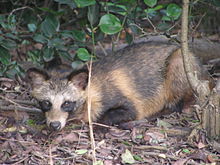
Nyctereutes procyonoides

The raccoon dog (Nyctereutes procyonoides, from the Greek words nukt-, 'night' + ereutēs, 'wanderer' + prokuōn, 'before-dog' + -oidēs, 'similar to'), also known as the mangut (its Evenki name), tanuki or neoguri is a canid indigenous to East Asia. It is the only extant species in the genus Nyctereutes. It is unrelated to raccoons, and it is a close relative of true foxes rather than the domestic dog. Among the Canidae, the raccoon dog shares the habit of regularly climbing trees only with the North American gray fox, another basal species. The raccoon dog is named for its superficial resemblance to the raccoon (Procyon lotor), to which it is not closely related. In Japan, it is known as the tanuki, and has a long history in folklore. In Sweden, where it is called mårdhund ('marten-dog'), it has been treated as a potentially hazardous invasive species. Raccoon dog skulls greatly resemble those of South American foxes, particularly crab-eating foxes, though genetic studies reveal they are not closely related. Their skulls are small, but sturdily built and moderately elongated, with narrow zygomatic arches. The projections of the skull are well developed, the sagittal crest being particularly prominent in old animals. In reflection of their omnivorous diets, raccoon dogs have small and weak canines and carnassials, flat molars, and relatively long intestines (1.5–2.0 times longer than other canids). They have long torsos and short legs. Total lengths can range from 45 to 71 cm (18 to 28 in). The tail, at 12 to 18 cm (4.7 to 7.1 in) long, is short, amounting to less than a third of the animal's total length and hangs below the tarsal joints without touching the ground. The ears are short and protrude only slightly from the fur. Weights fluctuate according to season: in March they weigh 3 kg (6.6 lb), while in August to early September males average 6.5–7 kg (14–15 lb), with some individuals attaining a maximal weight of 9–10 kg (20–22 lb). Specimens from Japanese and Russian studies have been shown to be on average larger than those from Chinese studies. The winter fur is long and thick with dense underfur and coarse guard hairs measuring 120 mm in length. The winter fur protects raccoon dogs from low temperatures ranging down to −20° to −25°C. It is of a dirty, earth-brown, or brownish-grey colour with black guard hairs. The tail is darker than the torso. A dark stripe is present on the back, which broadens on the shoulders, forming a cross shape. The abdomen is yellowish-brown, while the chest is dark brown or blackish. The muzzle is covered in short hair, which increases in length and quantity behind the eyes. The cheeks are coated with long, whisker-like hairs. The summer fur is brighter and reddish-straw coloured. A rare, white color phase occurs in this species in Japan and in China.
